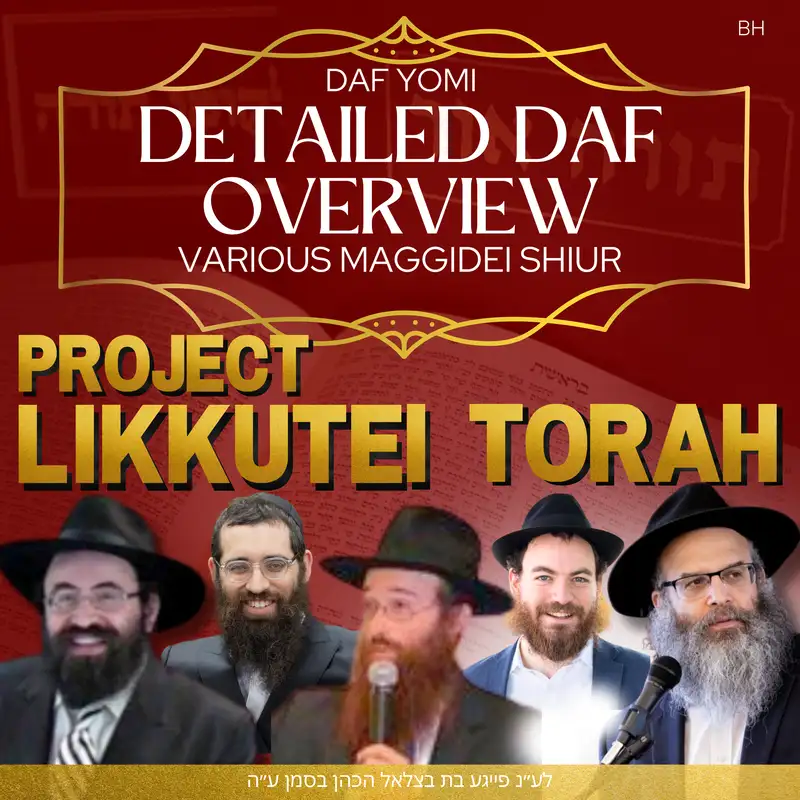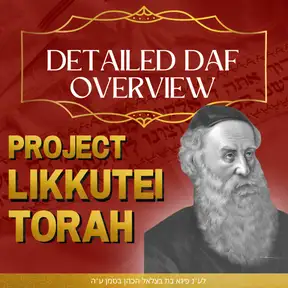
Torah Ohr Daf 49 - The Value of Deep Torah Study
Summary
With Rabbi Baruch Epstein from Chicago, ILBeginning the discourses on the book of Shmos!“v’Eileh shemos bnei Yisroel habaim Mitzrayma, es Yaakov, ishh u’beios bau”.Q1- Why do we repeat this descent of Yaakov into Egypt? We already mentioned it in parshas Vayigash!Q2- We need to understand the differences between the two descriptions of the descent of the BN”Y into Egypt.There are two stages in the descent into Galus and the ascent into Geulah. Yetzias Mitzrayim (YM) was only the first stage of Geuala. The second stage is Moshiach.“kimei tzeyscha m’eretz mitzrayim, arenu niflaos”: There is a correspondence between the redemption from Egypt and the Final Redemption. Just as our slavery in Egypt was a necessary stage before we could receive the Torah, so to our current “slavery” (and specifically, our intense study of Torah) leads to the revelation of the Hidden Torah (Taamei Torah)=Knowledge of Hashem=Moshiach.To elaborate:The Neshama’s descent into this world is for the sake of an ascent, which is experienced in Olam Haba/Gan Eden, and which has infinite, ever-ascending levels (“mishubach umifuar adei ad shmo hagadol”). The preparatory cleansing process of Gehenom was swapped, by Avraham, for Galus.The neshama, as a created and limited being, cannot both retain its individual existence and come into direct contact with/experience pleasure from Hashem Himself. Rather, it experiences the pleasure of Gan Eden through Torah (Chochma, and ultimately Kesser).There are three parts of Torah (specifically, Halacha), each of which expresses/relates to Hashem in a different way. The highest level is that of Mishna, which is the most expressive of Hashem’s Will (Ratzon) and Wisdom (Chochma). On a lower level are Braisos, which were not included in the Mishnah. The third level is that of Gemarah, in which the Halacha (i.e. Hashem’s Chochma/Ratozn) is not clear. Through our study and Halachic conclusions, we draw down the deepest levels of Hashem’s Wisdom into Gemarah, ourselves, and the world. Now we can understand the meaning of the statement of the Zohar that “the purpose of Torah and Mitzvos is to cause a unity in Hashem’s Names”: There are seven Names of Hashem, which correspond to the seven lower Sefirot. Through Torah and Mitzvot, we cause 1) each individual name (a limited expression of Hashem) to be revealed, and 2) the general expression/unity of Havaya/Adnoai, which expresses Ein Sof throughout all the Sefiros. This deepest expression of Ein Sof can only be achieved in this world, through the Torah and Mitzvos performed by BN”Y.“v’Eileh shemos bnei Yisroel habaim Mitzrayma,”= the way we cause an expression of Hashem’s Names into this world, through Torah and Tefillah. However, in Galus, these expressions are not revealed in the world.ConceptsThere is a correspondence between the redemption from Egypt and the Final Redemption.The value of deep Torah study.For more resources, visit www.projectlikkuteitorah.com Support the showWith Rabbi Baruch Epstein from Chicago, IL
Beginning the discourses on the book of Shmos!
“v’Eileh shemos bnei Yisroel habaim Mitzrayma, es Yaakov, ishh u’beios bau”.
Beginning the discourses on the book of Shmos!
“v’Eileh shemos bnei Yisroel habaim Mitzrayma, es Yaakov, ishh u’beios bau”.
Q1- Why do we repeat this descent of Yaakov into Egypt? We already mentioned it in parshas Vayigash!
Q2- We need to understand the differences between the two descriptions of the descent of the BN”Y into Egypt.
- There are two stages in the descent into Galus and the ascent into Geulah. Yetzias Mitzrayim (YM) was only the first stage of Geuala. The second stage is Moshiach.
- “kimei tzeyscha m’eretz mitzrayim, arenu niflaos”: There is a correspondence between the redemption from Egypt and the Final Redemption. Just as our slavery in Egypt was a necessary stage before we could receive the Torah, so to our current “slavery” (and specifically, our intense study of Torah) leads to the revelation of the Hidden Torah (Taamei Torah)=Knowledge of Hashem=Moshiach.
- To elaborate:
- The Neshama’s descent into this world is for the sake of an ascent, which is experienced in Olam Haba/Gan Eden, and which has infinite, ever-ascending levels (“mishubach umifuar adei ad shmo hagadol”). The preparatory cleansing process of Gehenom was swapped, by Avraham, for Galus.
- The neshama, as a created and limited being, cannot both retain its individual existence and come into direct contact with/experience pleasure from Hashem Himself. Rather, it experiences the pleasure of Gan Eden through Torah (Chochma, and ultimately Kesser).
- There are three parts of Torah (specifically, Halacha), each of which expresses/relates to Hashem in a different way. The highest level is that of Mishna, which is the most expressive of Hashem’s Will (Ratzon) and Wisdom (Chochma). On a lower level are Braisos, which were not included in the Mishnah. The third level is that of Gemarah, in which the Halacha (i.e. Hashem’s Chochma/Ratozn) is not clear. Through our study and Halachic conclusions, we draw down the deepest levels of Hashem’s Wisdom into Gemarah, ourselves, and the world.
- Now we can understand the meaning of the statement of the Zohar that “the purpose of Torah and Mitzvos is to cause a unity in Hashem’s Names”:
There are seven Names of Hashem, which correspond to the seven lower Sefirot. Through Torah and Mitzvot, we cause 1) each individual name (a limited expression of Hashem) to be revealed, and 2) the general expression/unity of Havaya/Adnoai, which expresses Ein Sof throughout all the Sefiros. This deepest expression of Ein Sof can only be achieved in this world, through the Torah and Mitzvos performed by BN”Y.
- “v’Eileh shemos bnei Yisroel habaim Mitzrayma,”= the way we cause an expression of Hashem’s Names into this world, through Torah and Tefillah. However, in Galus, these expressions are not revealed in the world.
Concepts
- There is a correspondence between the redemption from Egypt and the Final Redemption.
- The value of deep Torah study.
For more resources, visit www.projectlikkuteitorah.com
★ Support this podcast ★
